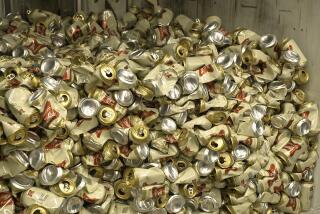Beer Battling Back for Imbibers
- Share via
CHICAGO — Beer sales had gone flat, while wine was flying off the shelves.
So beer makers decided to steal a page from wine’s marketing manual and create new packaging, flavors and drinks. Now beer is coming back.
The major brewers “blended, became the same,” said Nick Lake, beer expert at ACNielsen, the marketing information company.
“If they didn’t have the brand in some ads -- a Budweiser ad, a Miller Lite ad, a Coors ad -- if they didn’t have the can in it, it could be any one of the three,” said Lake, the company’s vice president of new business development.
Now, brewers are pitching their beer as cooler, classier and more healthful, trying to do for their beverage what Starbucks Corp. has done for coffee.
The result is that people are finally buying more beer. After idling for the last couple of years, beer sales have shown steady growth in recent months, Lake said. Craft beers and imports are driving the growth.
For the 12 months that ended April 22, national beer sales totaled $4.07 billion, up about 1.4% from a year earlier, according to ACNielsen.
Most of the increase was attributed to double-digit percentage sales increases for imported brands and so-called craft brews. In all, 231 million cases were sold at food, drug and convenience stores combined, up 1% from a year earlier.
The fruity malt drinks, organic pale ale, lager and other new beer products that are driving the increase in sales are on display this week in Chicago at the Food Marketing Institute Show, the supermarket industry’s annual trade show.
Beer is still the drink of choice for at least half the people who drink alcohol in the United States, but wine and spirits have been enticing drinkers in ever-growing numbers.
A Gallup survey last year found that wine was the drink of choice for as many Americans as was beer.
The wine industry has jockeyed for attention with cute critters on the label, easy-open screw caps and cans and party-friendly boxes.
Basically, wine seemed to have become more fun. So beer companies started thinking about how to do more with their brews. And, in some instances, they joined forces.
“We can all compete, but then we can all be friends when it comes to beer versus a cosmo or a merlot,” said Bill Laufer, a spokesman for Anheuser-Busch Cos.
For beer, new packaging includes Heineken’s keg can for the fridge, which gives people draft beer at home. Molson Coors Brewing Co. sells a Coors cooler box with 18-ounce plastic bottles that is ready to be filled with ice and taken to the beach or a barbecue. And Budweiser, from Anheuser-Busch, comes in new sturdy aluminum bottles that are like a cross between a can and a glass bottle.
Beyond packaging is flavor. For Anheuser-Busch that means Bud Select, a light beer with a more robust taste.
Bud Select has been the bestselling new beer brand, Lake said.
The biggest sales potential is in so-called craft beers and imports, ACNielsen said. Anheuser-Busch recently signed a deal to distribute imports including Grolsch and Harbin. Miller’s parent, SABMiller, also sells Pilsener Urquell.
Recently, the St. Louis-based beer giant has rolled out several new products, including two micro-brew styles, Stone Mill Pale Ale and Wild Hop Lager, that are certified organic.
The company also has created a new malt beverage, Peels, made with all-natural fruit. That’s on top of Anheuser-Busch’s B-to-the-E and Tilt, which have sweet flavors, caffeine, ginseng and guarana, a Brazilian stimulant.
Healthful products are important to customers, which is another aspect of wine’s appeal, Lake said.
“The wine category, in particular red wine, has done a masterful job of selling the health benefits of red wine,” Lake said. “Who hasn’t heard that story? And the reality of it is you get the same health benefits from beer as you do from red wine.”
More to Read
Eat your way across L.A.
Get our weekly Tasting Notes newsletter for reviews, news and more.
You may occasionally receive promotional content from the Los Angeles Times.









